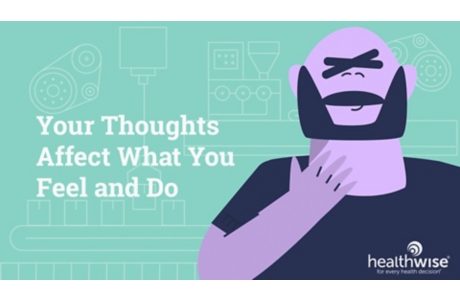Overview
Unhelpful thoughts, sometimes called negative thoughts, can keep you from enjoying life. They can also worsen problems like anxiety, depression, and pain. Learning healthy thinking habits can help with negative thoughts.
What is healthy thinking?
Healthy thinking is a way to help you stay well or cope with a problem by changing how you think. And how you think can affect how you feel and what you do.
If you think in a healthy way, you may be more able to care for yourself and handle life's challenges. You will feel better. And you may be more able to avoid or cope with stress, anxiety, and depression.
You can help yourself with healthy thinking through:
- Cognitive-behavioral therapy. This type of therapy, also called CBT, is often used to help people think in a healthy way. It focuses on thought (cognitive) and action (behavioral).
- Gratitude. This means saying thanks for everything that is important to you and good in your life.
- Optimism. Optimism is a hopeful, positive outlook on the future, yourself, and the world around you. It helps you see, feel, and think positively.
What are the benefits of healthy thinking?
Healthy thinking can help you better manage day-to-day stress. It can also help with handling the difficulties of some chronic conditions. Healthy thinking can help you feel more hopeful or positive. That can help you feel better about yourself, your life, or a challenge you're facing.
How can cognitive behavioral therapy help?
Cognitive behavioral therapy, also called CBT, is a way to help you stay well or cope with a problem by changing how you think and behave.
CBT can help you learn to think in a healthy way. It can help you notice negative thoughts and reframe them so they're more helpful.
If you learn how to reframe negative thoughts, you may be more able to care for yourself and handle life's challenges. You will feel better. And you may be more able to avoid or cope with stress, anxiety, and depression.
CBT also teaches you how to notice and change unhelpful behavior. For example, you might learn ways to respond to stress differently by calming your mind and body. Techniques may include meditation, yoga, muscle relaxation, or guided imagery.
Many people work with a therapist or a counselor for CBT. But you also can practice CBT skills on your own.
You can use your CBT skills throughout your life. You may find that more "tune-up" sessions help you stay on track with your new skills.
How can you choose a counselor or therapist?
When you call to make an appointment, ask to speak with the therapist or counselor, if possible. Explain what you want help with. Then ask if they have experience with this issue and what their views are. If you go to a therapist and don't like what happens, try again with someone new.
Related Information
Credits
Current as of: June 24, 2023
Author: Healthwise Staff
Clinical Review Board
All Healthwise education is reviewed by a team that includes physicians, nurses, advanced practitioners, registered dieticians, and other healthcare professionals.
Current as of: June 24, 2023
Author: Healthwise Staff
Clinical Review Board
All Healthwise education is reviewed by a team that includes physicians, nurses, advanced practitioners, registered dieticians, and other healthcare professionals.




